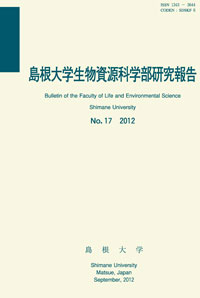島根大学生物資源科学部
ISSN:2435-0885(online)
ISSN:1343-3644(in print)
A publication of this bulletin in print format has not been made since no 24.
ISSN:1343-3644(in print)
A publication of this bulletin in print format has not been made since no 24.

number of downloads : ?
Use this link to cite this item : https://ir.lib.shimane-u.ac.jp/7291
Bulletin of the Faculty of Life and Environmental Science Shimane University 16
2011-09-30 発行
島根県奥出雲町の造林地土壌の理化学性への火入れの影響
Effect of slash and burn land preparation on soil properties in forest plantation sites in Okuizumo, Shimane.
File
Description
Slash and burn land preparation for reforestation has been conducted in Okuizumo region, Shimane for more than20years. In the present study, we investigated the effect of the burning on the soil physicochemical properties considering with passage of time after burning in forest plots with different years passed after the burning in this region. We also conducted a pot experiment to study the relationships between the soil with different years passed after the burning and soil course structure, and plant productivity. Soils were generally very porous with course pore spaces with solid phase volume less than 40%, except for sub soils of S15and S5sites. C/N ratio was relatively small in S5and K1, and was large in K3. Available P content was high at the surface soil in all sites. It was high in the order of K1>K3>S5>K11>S15>S11and was more than120mg kg−1in the sites of andisol and S5. It was suggested that avail. P level decreased as the time passed after the burnig. In the pot experiment with Komatsuna, K11, S5, K3, K1that had relatively high avail. P, exchangeable cations, total C and N contents showed better plant growth than the others. However, Komatsuna growth was correlated with not only the nutrients of NPK, but also development of soil course structure. Komatsuna growth was the biggest in K11 and S5where relatively long period had passed. In these sites, soil course structure started to re?develop from soil disturbance during red radish cultivation(1cropping season)associated after the burning. From these results, it was suggested that the passage of time after the burning influenced on plant growth through not only soil chemical properties change, i.e. soil fertility, but also soil course structure development.
About This Article
Other Article
